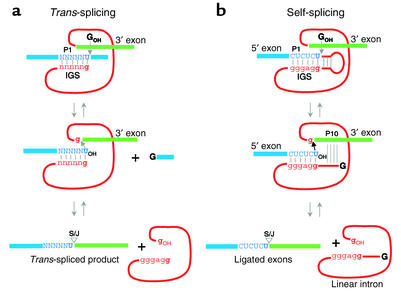Figure 1.
Comparison of self-splicing versus trans-splicing. The trans-splicing reaction (a) is similar to the natural self-splicing reaction (b) except that the target RNA is not covalently attached to the ribozyme. Exon sequences (blue and green) are shown as boxes and capital letters. Intron sequences (red) are shown as solid lines with lowercase letters. IGS, P1, and P10 helices are shown. The targeted uridine residue is shown as a bold letter and the splicing junction (S/J) is indicated. The exogenous guanosine nucleophile and terminal guanosine nucleotide of the ribozyme are shown as G (black) and g (red) respectively. A trans-splicing ribozyme binds a substrate RNA by forming bp’s (N-n) with the targeted transcript.

